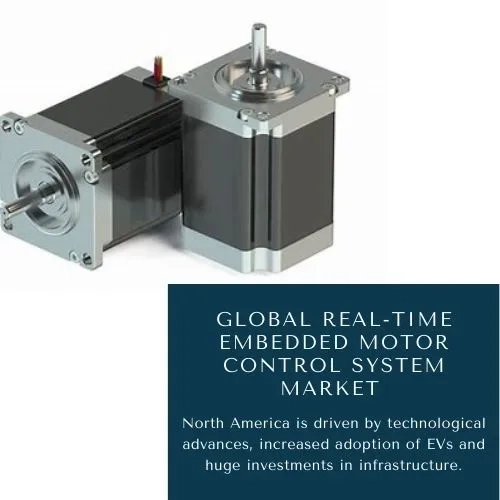
- Get in Touch with Us

Last Updated: Apr 25, 2025 | Study Period: 2024-2030
On the other hand, the real-time embedded motor control systems market is expanding at a significant CAGR as the demand for accuracy in the function of motors is increasing rapid industrial and automotive adoption propelling growth drivers which include growing penetration of electric vehicles, tremendous development through automation advancements, sectorial requirements for energy-efficient motor controls solution.IT connects high-performance Real-time Embedded Motor Control Systems to benefit achievable angle/motor performance with reduced power consumption thus improving reliability in various types of appliances working on electrical-driven applications. In combination with advanced control algorithms, these systems deliver real-time processing to provide accurate and efficient motor control.
The shift to electric and hybrid vehicles in the automotive sector is driving demand for real-time embedded motor control systems. Three critical systems that need to be monitored are the propulsion motor, steering, and braking system as control of this ensures efficient operation. Real-time motor control systems are integrated into electric vehicles, enabling features like regenerative braking which in turn improves the performance of the vehicle. This increased focus on autonomous driving technologies is, in turn, stoking demand for advanced control devices with complex device structures and networks.

Real-time embedded motor control systems are another fast-growing opportunity for PSoC in the industrial automation space. Design and implementation of automated control systems for machinery & equipment lead to improved efficiency in operation similar to increased productivity. For applications like robots, CNC machines, and conveyor systems, knowing how speed, torque, or position can be controlled is vital to design products of the specific domain. However, the implementation of Industry 4.0 and smart manufacturing has accelerated the need for modernized machining solutions to provide visibility into operations such as performance monitoring in real-time leading to operational efficiency and reduced production time by enhanced decision-making capabilities from sensing control algorithms.
Continuous technological advances and innovations have made the real-time embedded motor control systems market function very rapidly. The microcontroller, DSP technologies, and embedded control algorithms made it possible to realize new ideas in this field. Players in this market are concentrating on developing motor control solutions with improved performance, reliability, and energy efficiency, particularly for addressing the ever-changing requirements of different applications. The thing is born out of companies deriving the advantages from each other and availing new motor control rapid manufacturing technologies through strategic collaboration, and partnership.
Real-time embedded motor control systems are fundamental to modern industrial and automotive applications that require accurate manipulation of electric motors. Integrated systems that use embedded software and hardware combine real-time processing to guarantee compliance with the control of motor operation very accurately, as well as providing high efficiency. By enabling a more optimal motor operation, power consumption is reduced and systems become even more reliable in the long term for motor-driven applications. It is necessary for applications that need large and accurate amounts of speed, torque, or position control.
Embedded devices respond in real-time to subtle activity changes coming from a control system without the communication and execution latency used by such complex mechanisms. This is enabled by high-performance microcontrollers or digital signal processors (DSPs) that run control algorithms in real-time. These algorithms monitor motor parameters and adjust them as needed to get the best performance. Real-time systems utilization can detect and diagnose faults, which improves system reliability (thus reducing downtime) by helping to identify potential troubles faster.
For example, the automotive industry depends on real-time embedded motor control systems to enable its hybrid electric vehicle solutions. They govern motor functions such as acceleration, steering, and braking for the smooth operation of vehicles. The shift to electric vehicles has driven a requirement for high-level control devices designed for long-life operation in harsh environments and the demanding systems present on an electrical vehicle like regenerative (kinetic) braking which stores energy under deceleration to drive increase the performance of the overall vehicle.
Real-time devices are also increasingly employed in designs targeting applications that range from automotive components to industrial automation, robotics, and consumer electronics. They allow machines and facilities to be more rigidly controlled, boosting precision, and productivity. These are the systems that move and in the case of robots, they give us accurate motion control which is necessary to perform complex tasks at a high level of precision by a robot. It is used in consumer electronics for items such as appliances and power tools, where the mechanical performance must be extremely reliable. There are further possibilities arising by moving motor control on these new hardware platforms: It allows the continuous advancements of related technologies like embedded processing technology and real-time capable, dedicated control algorithms.

The Global Real-Time Embedded Motor Control System Market was valued at $XX Billion in 2023 and is projected to reach $XX Billion by 2030, reflecting a compound annual growth rate (CAGR) of XX% from 2024 to 2030.
Improved FOC (Field Oriented Control) system :There are advanced FOC (Field Oriented Control) algorithms, which can increase motor performance and decrease the power consumption within a given range; even better control for industrial or automotive applications.
Integration of safety features:This provides a functional safety standard and accessories that meet standards such as ISO 26262 (the automotive functional safety application), thereby enabling use in critical applications (e.g. Automotive, Robotic & Industrial Automation) where the sensors are operated safely.
Increased connectivity and IoT integration:Better communication paths, such as wireless protocols and IoT integration support the real-time remote monitoring of equipment condition-based maintenance systems to achieve minimal downtime and peak system performance.
Power efficiency and heat management:The reduction in power consumption and emphasis on thermal efficiency for extended component life spans result in higher system reliability generally reducing operating costs, especially with battery applications.
STMicroelectronics â STSPIN32F0A :
It is one of the most innovative products offered by STMicroelectronics. This device merges the STM32 microcontroller and motor in a single device access to real-time control with FOC. It also features low brief and high reliability, along with suitable built-in safety provisions. These devices are ideal for industrial automation, robotics, and home appliances.
Microchip Technology â dsPIC33CK:
dsPIC33CK is Microchip Technologyâs high-performance digital control chip. The device is designed for use in digital signal controllers tailored for motor control and the automatic control of a motor. The dual-core architecture allows for parallel operation, and cutting-edge motor control peripherals, making them suitable candidates for electric cars, servo motors, and HVAC systems.
Texas Instruments- C2000 F2838x:
The C2000 F2838x series real-time microcontrollers from Texas Instruments are designed for big horsepower motor control applications. These controllers have real-time CLA processing CLA, a comprehensive multi-channel ADC high PWM, and a variety of other key capabilities for real-world high-performance performance making them ideal choices for industrial drives, renewable energy, and vehicle energy monitoring.
NXP semiconductor- S32K1:
S32K1 from NXP Semiconductor is a scalable response solution to the new real-time embedded motor control situation. These chips have high-performance Arm Cortex M0+/M4 cores with enhanced motor control with timers and resilient safety provisions. They are suitable candidates for automotive motor control, industrial automation and consumer electronics.
| Sr.N0 | Topic |
| 1 | Market Segmentation |
| 2 | Scope of the report |
| 3 | Research Methodology |
| 4 | Executive Summary |
| 5 | Average B2B by price |
| 6 | Introduction |
| 7 | Insights from Industry stakeholders |
| 8 | Key Drivers for Global Real-Time Embedded Motor Control System market |
| 9 | Disruptive Innovation in the Industry |
| 10 | Overview of Global Real-Time Embedded Motor Control System Market |
| 11 | Major impact on Technological advancements |
| 12 | Consumer trends in the industry |
| 13 | Recent technological trends in Global Real-Time Embedded Motor Control System Market |
| 14 | SWOT Analysis of Key Market Players |
| 15 | New product development in the past 12 months |
| 16 | Market Size, Dynamics, and Forecast by Geography , 2024-2030 |
| 17 | Market Size, Dynamics, and Forecast by Component , 2024-2030 |
| 18 | Market Size, Dynamics, and Forecast by Motor Type , 2024-2030 |
| 19 | Market Size, Dynamics, and Forecast by Application , 2024-2030 |
| 20 | Competitive landscape |
| 21 | Gross margin and average profitability of suppliers |
| 22 | Merger and Acquisition in the past 12 months |
| 23 | Growth strategy of leading players |
| 24 | Market share of vendors, 2023 |
| 25 | Market Company Profiles |
| 26 | Unmet needs and opportunities for new suppliers |
| 27 | Conclusion |